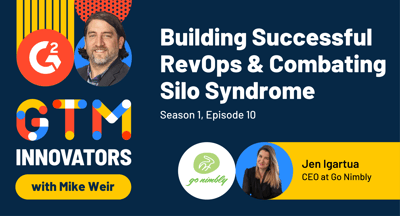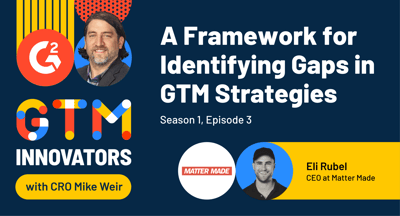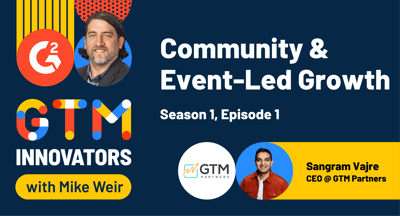May 23, 2023
 by Stephen Hoops / May 23, 2023
by Stephen Hoops / May 23, 2023

There’s one word you’ve heard as of late in the tech industry: efficiency.
In a time where many are pulling back costs over uncertainties around inflation and economic slowdown, software companies are exploring how they can be more efficient. Marketing and sales teams are expected to do more with less, which will likely be the case for some time.
It makes sense that tech stacks are a logical place to examine when evaluating areas to trim. This has led to the rise of consolidation of software solutions, leaving some teams with the task of crafting workarounds to make it all work together. Sometimes, this can result in a new set of challenges.
Chris Hays is President and Chief Operating Officer at ZoomInfo. He oversees all customer-facing operations, including customer success and onboarding, learning and development, and all aspects of the company’s go-to-market organization. A GTM expert for over two decades, Chris was formerly a sales and marketing leader at companies like Lucent and Avaya.
Chris Hays joined G2 Chief Revenue Officer Mike Weir for the latest episode of the GTM Innovators podcast to discuss ways software companies can uncover opportunities to achieve greater efficiency. In this episode recap, you’ll learn about Chris’ perspectives on consolidation and how to strike the right balance of scale and personalization.
B2B software started picking up serious momentum in the late 2000s. With a boom in Martech software solutions during this time, B2B companies would soon have a world of choice to source software that fit their many needs.
Companies brought in more point solutions, and the tech stack grew at a quicker pace. This worked for a time, but Chris shared his thoughts on how this has recently changed.
“When things start to get a little bit choppier, and expenses get evaluated in a different way, people are getting forced into an efficiency matrix that they weren't in before.”
Chris Hays
President, Chief Operations Officer at ZoomInfo
Consider that companies with over 1,000 employees utilize more than 150 different software on average. At a time when many companies are looking to cut costs, finance teams and executive leadership begin to question which solutions are mission-critical and which ones are good enough.
Consolidation makes sense, especially if you’re able to find cost savings. It’s even better if you can unlock efficiencies. The problem then deals with what Chris affectionately calls the “Frankenstack.”
The Frankenstack is essentially the result of consolidating solutions to the point where companies may have to sacrifice connectivity between the ones they keep. As Chris mentions, that lack of efficiency eventually has its own cost in some form.
Despite many sales and marketing tech merging and proliferating, it’s unlikely that any one software can be the best-in-class at everything.
Tip: Choosing which software is nice to have and absolutely necessary can be tricky. Check out the full podcast episode to hear Chris Hays’ perspective on how to weigh the pros and cons of consolidation versus choosing a best-in-class solution.
Consolidation is just one concept companies should explore when uncovering opportunities for better efficiency. Chris shared his expert tips on how to master the right amount of personalization at scale.
Personalization is a powerful tool go-to-market teams utilize to establish a stronger connection with buyers and customers. With a little effort, it can be a game changer for making these audiences feel you care more about them.
The challenge is figuring out just how much customization and effort to apply. For this, Chris talked about the importance of contextual awareness.
“Depending on where the message is coming from, that dictates how much customization goes into the messaging,” says Chris. “We'll start off hyper-customized and then deconstruct that to the point where we don’t lose anything.”
The idea is that sometimes it makes sense to go broader with your messaging if the benefits are there. However, there are instances where spending that extra time to develop an impactful and concise message is worth the effort.
Performance data is extremely vital to any go-to-market strategy. To home in on what’s working and what needs to change, Chris recommends reviewing your key metrics can shed light on how to optimize your personalization efforts.
Over time, you’ll get a sense of your metrics, such as open rates, call rates, percentage of meetings or demos booked, and more. To take it further, Chris suggests documenting these benchmarks relative to your personas and measuring your custom messaging against those typical baselines.
B2B SaaS companies with inside sales teams, such as BDRs and SDRs, may not realize how much call coverage can impact meeting rates when used with personalization.
Let’s say you have over 10k leads and drop them into a sequence or cadence. Applying a call coverage segment will often reveal which messaging works best with outbound efforts. This is another example of how you can examine your data to understand if your personalization measures are paying off.
“You can see those things coming together where the act of an email plus a call gets to the outcome you want,” says Chris. “It gives you an idea about where you want to spend that outbound SDR resource.”
When in doubt, consult your funnels. Seasoned go-to-market teams appreciate how carefully composed funnels will always be a guiding component of their strategies. As mentioned earlier, a key aspect to nail down for personalization at scale involves understanding where the message is coming from. According to Chris, he even “dreams in funnels.”
“When I think about [broad total addressable market] TAM, that's really where I want to go for scale, and maybe forego that hyper-customization,” says Chris. “But when we're marketing into an opportunity that's stalled out, maybe we need to get a little bit more people in the buying committee; that's where customization matters more.”
The higher up the funnel a buyer is, the less likely that broader messaging will have a negative impact. But as buyers move down the funnel, broader personalization that doesn’t include contextual awareness of the relationship until this point can do more harm than good. It’s best to utilize that extra time to explore more customized messaging to progress opportunities.
In both life and sales, timing is everything. One of the leading reasons why intent data is so impactful is that marketing and sales teams can utilize it to trigger meaningful, contextually relevant messaging in moments that matter most. This is another way companies can rethink how they do things to achieve greater efficiency.
When Chris and his team at ZoomInfo thought about timing in sales, they launched a series of experiments to understand the impact of follow-up times. You'll have to check out the full episode to see what they learned and how they applied it to their processes.
In episode 4 of GTM Innovators, the full conversation with Chris Hays includes other takeaways such as:
Watch the full episode on YouTube and learn more about Chris and other GTM experts by subscribing to the GTM Innovators podcast today - available on Spotify, Apple Podcasts, iHeartRadio, Amazon Music, and more.
Stephen Hoops is a former Sr. Content Marketing Specialist at G2. He focused on creating content that helps tech industry sales professionals and B2B SaaS marketers find success with G2 products such as Buyer Intent, Review Generation, and more. After receiving his B.A. in Journalism from West Virginia University in 2013, he has helped countless B2B brands reach new highs through content creation and SEO. When not nerding out about the artistry behind well-written copy, Stephen can be found info-dumping about homemade cocktails, Italian cuisine, and why vinyl is the superior physical medium for music.
Directors get too much credit for the most beloved movie franchises.
 by Stephen Hoops
by Stephen Hoops
It’s easy to feel optimistic when staring down that list of leads. Turning a prospect into a...
 by Stephen Hoops
by Stephen Hoops
The world as we know it is changing in front of our eyes.
 by Stephen Hoops
by Stephen Hoops
It’s easy to feel optimistic when staring down that list of leads. Turning a prospect into a...
 by Stephen Hoops
by Stephen Hoops
Directors get too much credit for the most beloved movie franchises.
 by Stephen Hoops
by Stephen Hoops


